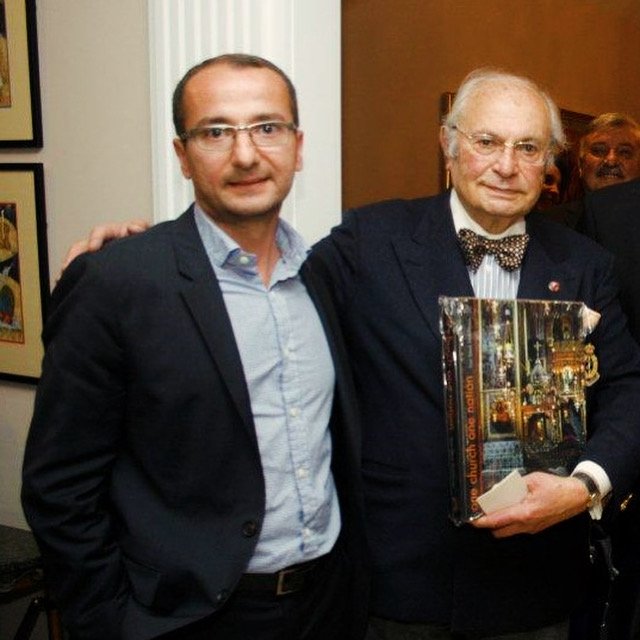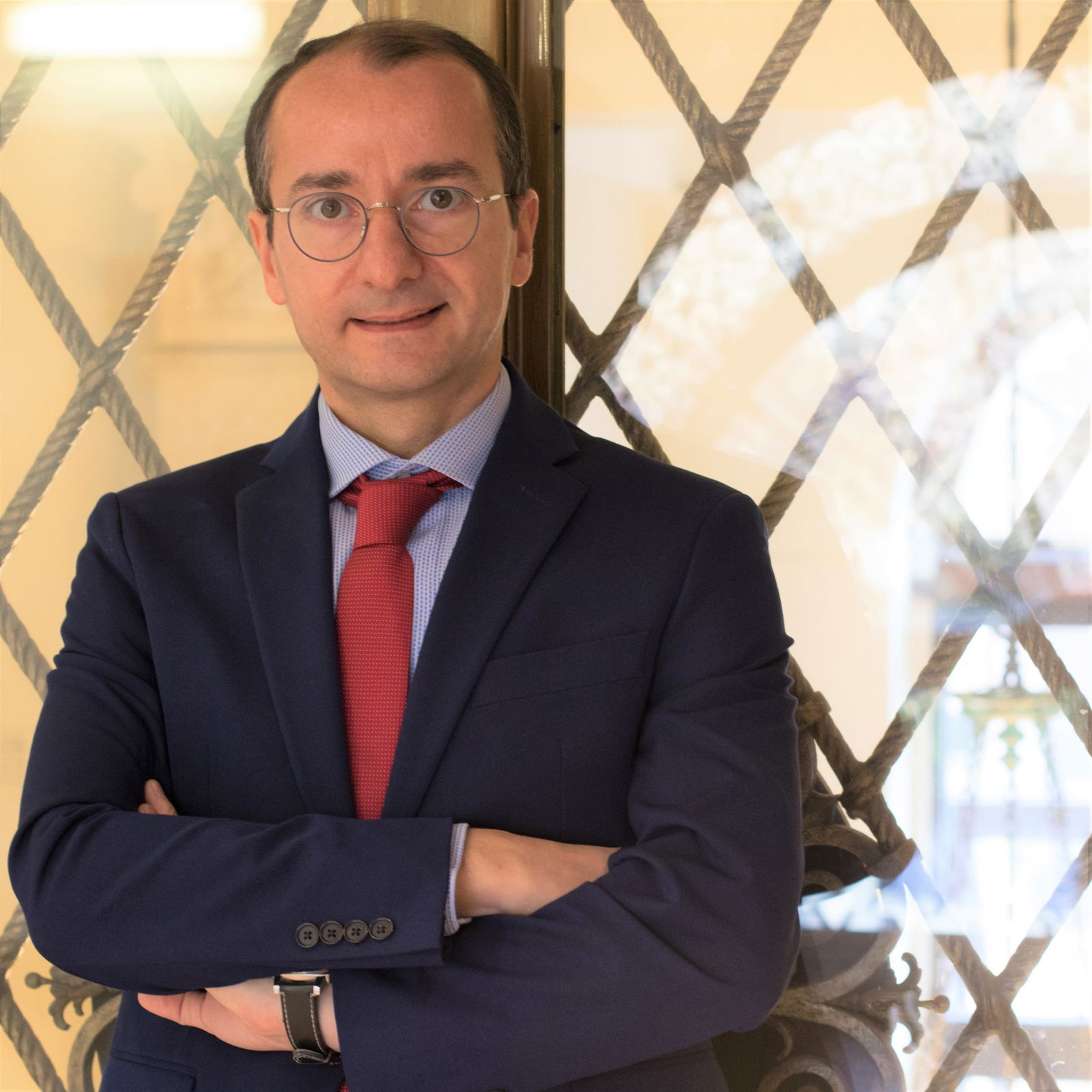The following eulogy was delivered by Dr. Khatchig Mouradian at Dr. Henry D. Astarjian’s funeral services held at St. Stephen’s Armenian Apostolic Church on April 11, 2024.
When I conjure Dr. Astarjian, it always seems like he just walked to the stage to deliver a rousing speech, or he marched out of a history book—or is about to make history. He is invariably wearing a suit, a bowtie (or a tie), a handkerchief peeking from the pocket of his jacket and a pipe in his hand. (One might even imagine him barbecuing in his suit.) Every word he utters, every move he makes, seems measured and deliberate. Whatever space he steps into becomes his boardroom, his situation room, his banquet hall.
Dr. Astarjian was always ready for the world. Perhaps it is more accurate to say for the worlds he traversed, and for the many lives he lived during his one lifetime: from Kirkuk and Baghdad to London, New York and New Hampshire; the world of his medical practice; the realm of Armenian, Kurdish and Middle Eastern political commentary; and the world of his family and close friends.
Dr. Astarjian also led a parallel and no less rich life of the mind. He would spend hours reading in his favorite spot at the house, under his oil paintings depicting the citadel of his birthplace Kirkuk, which he painted in his early teens (in 1947!). For every word he uttered, he read a thousand. There were always several books and newspapers in Arabic, English and Armenian on the side table—history books, newspapers and almost always the biography of a leader. He counseled me to read biographies of prominent figures—he considered them invaluable for shaping one’s character and honing one’s leadership skills.

Neurologist, author (of the book The Struggle for Kirkuk: The Rise of Hussein, Oil, and the Death of Tolerance in Iraq, which has been translated twice into Arabic in Beirut and Iraqi Kurdistan), painter, polyglot, orator, three times a speaker in the Kurdish parliament in exile (about the Sevres Treaty and Armenian rights), Republican National Convention delegate from the state of New Hampshire in 1992, the first person to bring a CT scan to their medical practice in New Hampshire, political commentator and columnist (including for the Armenian Weekly), Astarjian was a veritable renaissance man.
Many people view the world through the lens of losses they suffered, denied opportunities that went to people they deem less deserving, with a sense of victimhood clouding their vision. Not Dr. Astarjian. His time as a political prisoner in Iraq—he spent weeks in incarceration and was subject to terrible acts of torture there—the death of his brother Noreeg at the age of 23 at a checkpoint in Iraq (Noreeg took his last breath in Dr. Astarjian’s arms), and the many trials and tribulations he confronted in the decades since did not make him jaded and did not blunt his sense of humor and good cheer. They only strengthened his resolve.
A child of Armenian Genocide survivors who hailed from Marash, Dr. Astarjian refused to be defined by the crime, and, here too, never subscribed to narratives of victimhood. He believed in struggle, in unflinching demands for justice and had little patience for trifle pursuits that distracted leaders from core issues. Dr. Astarjian’s brand of leadership comprised big ideas and grand projects. He often criticized Armenian community leaders for busying themselves with municipal work—belediyyeyi kordz, he would call it combining Arabic and Armenian. He lamented the tendency among leaders to operate within comfort zones and spaces that offered limited room to maneuver. “This group is swimming on one side of the pool, the other group is swimming on the other side of it,” he would say, outraged by their reluctance to get out of the pool and step into the ocean!
Mind you, Dr. Astarjian did not just share these views with friends and family. He said it from the podium during public events and to the faces of people whose leadership he disapproved of. This should come as no surprise to most of us gathered here to honor his life and legacy. When Dr. Astarjian spoke, he spoke his mind. If you didn’t like what he had to say, tough luck! Sure, he was friendly and jovial in social settings, but conceit and flattery were not his thing. Many people respected him for his opinions, many others dreaded him, but those who tried to cajole him, sweet talk their way to his approval and bend him to their will, were often disappointed.
The Armenian Revolutionary Federation was near and dear to Dr. Astarjian’s heart—and he expected much from the organization. I was always amused by the fact that the license plates on his cars were ARF-1 and ARF-2. I have in my study one such license plate of his from 1991. I joked that he moved to New Hampshire only because the state motto is “Live Free or Die,” which echoes the ARF’s “azadutyun gam mah” (freedom or death)—a perfect combo for his car.

I met Dr. Astarjian when I had just moved to the U.S. in my late 20s. Within weeks, we were fast friends. He (already in his 70s at that point) and his wonderful wife Arev embraced me as one of their own. “Arev is your aunt (morkour),” he declared once, and the title stuck. “Say hello to my aunt,” I would tell him every time before we hung up.
Hardly a week passed when we didn’t meet for lunch or talk over the phone. “Izzeyyak ya daktor?” (How are you, doctor?) I would ask him cheerfully every time he picked up the phone—an Iraqi Armenian and a Lebanese Armenian greeting one another in Egyptian Arabic! “Zeyyiz zift” (Literally, like asphalt) he would joke with a hearty laughter. When he called, he always opened with “Ya varbed” (boss, in Armenian)—harkening back to the days when he served as a columnist for the newspaper I edited.
The morning Dr. Astarjian passed away, it dawned on me that he was the only person in my circle whom I have never called, or referred to, by their first name. When I spoke to others, he was Dr. Astarjian. When I spoke to him, he was ya Daktor.
My last conversations with Dr. Astarjian were mostly about family: my personal life, the blessings he felt for having his family—his siblings, his kids and, of course, his wife Arev—around.
The words Dr. Astarjian used in The Struggle for Kirkuk to describe the loss of his brother Noreeg would perhaps aptly describe what many of us gathered here feel today: Noreeg was no longer “a person whom I could hug, and kiss, and talk to, he was only a precious spirit, whom I could take with me anywhere I want!”
I do not know the dress code in the place from where Dr. Astarjian is watching us right now. But I imagine him, as always, wearing a suit, a bowtie (or a tie), a handkerchief peeking from the pocket of his jacket, and, most likely, a pipe in his hand.
For the memories, for the lessons you taught me, and for the inspiration, thank you, ya Daktor.



A lovely tribute. Bravo Khatchig